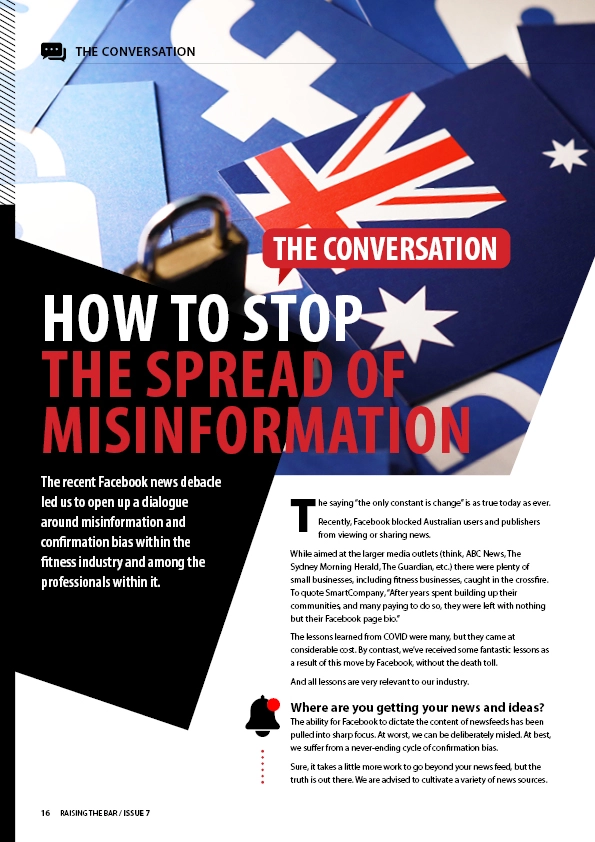the conversation
The Conversation: How to Stop the Spread of Misinformation

The saying “the only constant is change” is as true today as ever.
Recently, Facebook blocked Australian users and publishers from viewing or sharing news.
While aimed at the larger media outlets (think, ABC News, The Sydney Morning Herald, The Guardian, etc.) there were plenty of small businesses, including fitness businesses, caught in the crossfire. To quote SmartCompany, “After years spent building up their communities, and many paying to do so, they were left with nothing but their Facebook page bio.”
The lessons learned from COVID were many, but they came at considerable cost. By contrast, we’ve received some fantastic lessons as a result of this move by Facebook, without the death toll.
And all lessons are very relevant to our industry.
Where are you getting your news and ideas?
The ability for Facebook to dictate the content of newsfeeds has been pulled into sharp focus. At worst, we can be deliberately misled. At best, we suffer from a never-ending cycle of confirmation bias.
Sure, it takes a little more work to go beyond your news feed, but the truth is out there. We are advised to cultivate a variety of news sources.
Facebook can shut down anything at any time.
Including your Facebook Groups.
Even before this recent event, I’ve known people that had to deal with having their Facebook Group (and in one instance, their account) shut down. More than one was a result of their account being hacked and others were a victim of a random error. In every case, rectifying things was as easy as you would expect with a company trying to administer 2.8 billion users.
If Facebook is at the heart of your communication with clients, it might be worth considering more secure alternatives. In the very least, every business should be building and cultivating its own email list for communicating with clients.
Recognising both the value and limitations of social networks, for our FITREC members we’ve recently invested in FITREC Circle. It’s a proprietary social network that offers greater privacy and avoids that whole ‘if you’re not paying, you’re the product’ issue. Freeing our members from the need to be signed to any social network, and the associated ads and trackers that come with them, might seem to be over the top and maybe not for every business, but we believe it is best practice.
There is value in keeping personal and professional separate.
This is less related to the recent blocking of news issue and more to do with professionalism. There are often instances on social media where professionals provide information about themselves or their opinions that they would not blurt out in the gym. Even in instances where comments seem benign, there is the chance that they may be taken out of context and threaten your credibility and reputation, if not your job/business.
Consider ways in which you can communicate with your clients away from where you (and, just as importantly, your friends) are sharing your more intimate details.
Apart from the old favourites of email and text, an alternative that our team uses to communicate is Telegram. It’s free, encrypted, allows for you to create groups, post scheduled messages and more. Another popular platform is Signal. Both of these alternatives have gained millions of users following the recent concern surrounding updates to WhatsApp’s Terms of Use.
Are we suggesting you turn your back on Facebook?
Nope.
I understand that great swathes of the population are very heavily invested in Facebook for communicating with others. But in the same way that COVID taught us about diversifying and adapting our businesses, I would hope that this experience with Facebook encourages people to consider diversifying their communication with clients, family and friends.
As ever, the degree to which unexpected events will impact us is directly proportional to the power we give it. ®

DOWNLOAD THIS ARTICLE PDF HERE
- The Conversation: How to Stop the Spread of Misinformation